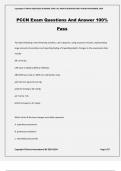Exam (elaborations)
PCCN Exam Questions And Answer 100% Pass
Institution
Practice Tests
PCCN Exam Questions And Answer 100%
Pass
Two days following a near-drowning accident, a pt is dyspneic, using accessory muscles, expectorating
large amounts of secretions and reporting feeling of impending death. Changes to the assessment data
include
RR- 24 TO 36
CXR clear to bilateral diffu...
[Show more]
Preview 4 out of 57 pages
Uploaded on
November 4, 2024
Number of pages
57
Written in
2024/2025
Type
Exam (elaborations)
Contains
Questions & answers
Institution
Practice Tests
Course
Practice Tests
$12.49
100% satisfaction guarantee
Immediately available after payment
Both online and in PDF
No strings attached
Copyright © KAYLIN 2024/2025 ACADEMIC YEAR. ALL RIGHTS RESERVED FIRST PUBLISH NOVEMBER, 2024




